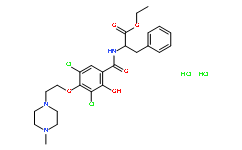| Cas No.: | 188791-09-5 |
| Chemical Name: | N-[3,5-Dichloro-2-hydroxy-4-[2-(4-methyl-1-piperazinyl)ethoxy]benzoyl]-L-phenylalanine ethyl ester dihydrochloride |
| Synonyms: | JTE-607 |
| SMILES: | Cl.Cl.CCOC(=O)C(CC1=CC=CC=C1)NC(=O)C2=C(O)C(Cl)=C(OCCN3CCN(C)CC3)C(Cl)=C2 |
| Formula: | C25H31N3O5Cl2.2[HCl] |
| M.Wt: | 597.35862 |
| Purity: | >98% |
| Sotrage: | 0°C (short term), -20°C (long term), desiccated |
| Description: | JTE-607, a highly selective inflammatory cytokine synthesis inhibitor, protects from endotoxin shock in mice. JTE-607 inhibits inflammatory cytokine production, including TNF-α, IL-1β, IL-6, IL-8 and IL-10, from LPS-stimulated human PBMCs, with IC50s of 11, 5.9, 8.8, 7.3 and 9.1 nM, respectively[1]. Cleavage and Polyadenylation Specificity Factor 3 (CPSF3) is the target of JTE-607[2]. |
| In Vivo: | JTE-607 (0.3-10 mg/kg, i.v.) shows dose dependent inhibition of mortality after LPS challenge in C. parvum sensitized mice in accordance with a decrease of plasma TNF-α[1]. Animal Model: Male C57BL/6 mice (5 to 6 weeks old) are sensitized by injecting Corynebacterium parvum[1] Dosage: 0.3, 1, 3, 10 mg/kg Administration: Administered intravenously 10 min before the LPS challenge. Result: Showed dose dependent inhibition of the mortality at 0.3 to 10 mg/kg and significant effect at 3 and 10 mg/kg. |
| In Vitro: | JTE-607 inhibits inflammatory cytokine production, including TNF-α, IL-1β, IL-6, IL-8 and IL-10, from LPS-stimulated human PBMCs, with IC50s of 11, 5.9, 8.8, 7.3 and 9.1 nM, respectively. The inhibitory effects of JTE-607 are also seen in mRNA expression of those cytokines[1]. JTE-607 inhibits inflammatory cytokine production from LPS-stimulated human PBMCs with an IC50 of approximately 10 nM[1]. JTE607 inhibits LPS-stimulated IL-8 production from monkey and rabbit PBMCs, and TNF-α production from mouse and rat PBMCs with IC50s of 59, 780, 1600 and 19000 nM, respectively[1]. JTE607 also suppresses other cytokines, granulocyte-macrophage colony stimulating factor and IL-1RA with IC50s of 2.4±0.8 and 5.4±0.4 nM, respectively[1]. JTE-607 inhibits cytokine production in monkey, rabbit, mouse and rat with IC50s of 59±26, 780±120, 1600±650 and 19000±3200 nM, respectively[1]. RT-PCR[1] Cell Line: human peripheral blood mononuclear cells (PBMCs) Concentration: 100 nM Incubation Time: 20 hours Result: Reduced the increase in the level of mRNAs of TNF-α, IL-1b, IL-6 and IL-8. |
| References: | [1]. M Kakutani, et al. JTE-607, a novel inflammatory cytokine synthesis inhibitor without immunosuppression, protects from endotoxin shock in mice. Inflamm Res. 1999 Aug;48(8):461-8. [2]. Nathan T Ross, et al. CPSF3-dependent pre-mRNA processing as a druggable node in AML and Ewing's sarcoma. Nat Chem Biol. 2020 Jan;16(1):50-59. |

 To enhance service speed and avoid tariff delays, we've opened a US warehouse. All US orders ship directly from our US facility.
To enhance service speed and avoid tariff delays, we've opened a US warehouse. All US orders ship directly from our US facility.




















